#at their current rate of user growth
Explore tagged Tumblr posts
Text
i have got to make more queer art
#i realized i haven’t been creating much of anything and it gives a lot of traction for my top surgery fund…#joining other social media platforms seems very much like a moot point because growing on any of them is excruciating#at their current rate of user growth#also a lot of the reel/short/tiktok set ups are only viewed#not engaged with#meaning my entire reason for participating in them would be ignored#i may start using one of those sticker sites too#those do quite well#i just won’t be able to get the money i need at this rate#and i need to start college late next year too#or january 2026#why must everything require so much money from me. i looked into community college btw it’s not very fruitful#i may pursue an associates there but i need to talk to a counselor…. depending on what kind of grants i get as a#working-poor 20 year old of independent financial status the cost difference might not mean anything#me
4 notes
·
View notes
Text
Tumblr’s Core Product Strategy
Here at Tumblr, we’ve been working hard on reorganizing how we work in a bid to gain more users. A larger user base means a more sustainable company, and means we get to stick around and do this thing with you all a bit longer. What follows is the strategy we're using to accomplish the goal of user growth. The @labs group has published a bit already, but this is bigger. We’re publishing it publicly for the first time, in an effort to work more transparently with all of you in the Tumblr community. This strategy provides guidance amid limited resources, allowing our teams to focus on specific key areas to ensure Tumblr’s future.
The Diagnosis
In order for Tumblr to grow, we need to fix the core experience that makes Tumblr a useful place for users. The underlying problem is that Tumblr is not easy to use. Historically, we have expected users to curate their feeds and lean into curating their experience. But this expectation introduces friction to the user experience and only serves a small portion of our audience.
Tumblr’s competitive advantage lies in its unique content and vibrant communities. As the forerunner of internet culture, Tumblr encompasses a wide range of interests, such as entertainment, art, gaming, fandom, fashion, and music. People come to Tumblr to immerse themselves in this culture, making it essential for us to ensure a seamless connection between people and content.
To guarantee Tumblr’s continued success, we’ve got to prioritize fostering that seamless connection between people and content. This involves attracting and retaining new users and creators, nurturing their growth, and encouraging frequent engagement with the platform.
Our Guiding Principles
To enhance Tumblr’s usability, we must address these core guiding principles.
Expand the ways new users can discover and sign up for Tumblr.
Provide high-quality content with every app launch.
Facilitate easier user participation in conversations.
Retain and grow our creator base.
Create patterns that encourage users to keep returning to Tumblr.
Improve the platform’s performance, stability, and quality.
Below is a deep dive into each of these principles.
Principle 1: Expand the ways new users can discover and sign up for Tumblr.
Tumblr has a “top of the funnel” issue in converting non-users into engaged logged-in users. We also have not invested in industry standard SEO practices to ensure a robust top of the funnel. The referral traffic that we do get from external sources is dispersed across different pages with inconsistent user experiences, which results in a missed opportunity to convert these users into regular Tumblr users. For example, users from search engines often land on pages within the blog network and blog view—where there isn’t much of a reason to sign up.
We need to experiment with logged-out tumblr.com to ensure we are capturing the highest potential conversion rate for visitors into sign-ups and log-ins. We might want to explore showing the potential future user the full breadth of content that Tumblr has to offer on our logged-out pages. We want people to be able to easily understand the potential behind Tumblr without having to navigate multiple tabs and pages to figure it out. Our current logged-out explore page does very little to help users understand “what is Tumblr.” which is a missed opportunity to get people excited about joining the site.
Actions & Next Steps
Improving Tumblr’s search engine optimization (SEO) practices to be in line with industry standards.
Experiment with logged out tumblr.com to achieve the highest conversion rate for sign-ups and log-ins, explore ways for visitors to “get” Tumblr and entice them to sign up.
Principle 2: Provide high-quality content with every app launch.
We need to ensure the highest quality user experience by presenting fresh and relevant content tailored to the user’s diverse interests during each session. If the user has a bad content experience, the fault lies with the product.
The default position should always be that the user does not know how to navigate the application. Additionally, we need to ensure that when people search for content related to their interests, it is easily accessible without any confusing limitations or unexpected roadblocks in their journey.
Being a 15-year-old brand is tough because the brand carries the baggage of a person’s preconceived impressions of Tumblr. On average, a user only sees 25 posts per session, so the first 25 posts have to convey the value of Tumblr: it is a vibrant community with lots of untapped potential. We never want to leave the user believing that Tumblr is a place that is stale and not relevant.
Actions & Next Steps
Deliver great content each time the app is opened.
Make it easier for users to understand where the vibrant communities on Tumblr are.
Improve our algorithmic ranking capabilities across all feeds.
Principle 3: Facilitate easier user participation in conversations.
Part of Tumblr’s charm lies in its capacity to showcase the evolution of conversations and the clever remarks found within reblog chains and replies. Engaging in these discussions should be enjoyable and effortless.
Unfortunately, the current way that conversations work on Tumblr across replies and reblogs is confusing for new users. The limitations around engaging with individual reblogs, replies only applying to the original post, and the inability to easily follow threaded conversations make it difficult for users to join the conversation.
Actions & Next Steps
Address the confusion within replies and reblogs.
Improve the conversational posting features around replies and reblogs.
Allow engagements on individual replies and reblogs.
Make it easier for users to follow the various conversation paths within a reblog thread.
Remove clutter in the conversation by collapsing reblog threads.
Explore the feasibility of removing duplicate reblogs within a user’s Following feed.
Principle 4: Retain and grow our creator base.
Creators are essential to the Tumblr community. However, we haven’t always had a consistent and coordinated effort around retaining, nurturing, and growing our creator base.
Being a new creator on Tumblr can be intimidating, with a high likelihood of leaving or disappointment upon sharing creations without receiving engagement or feedback. We need to ensure that we have the expected creator tools and foster the rewarding feedback loops that keep creators around and enable them to thrive.
The lack of feedback stems from the outdated decision to only show content from followed blogs on the main dashboard feed (“Following”), perpetuating a cycle where popular blogs continue to gain more visibility at the expense of helping new creators. To address this, we need to prioritize supporting and nurturing the growth of new creators on the platform.
It is also imperative that creators, like everyone on Tumblr, feel safe and in control of their experience. Whether it be an ask from the community or engagement on a post, being successful on Tumblr should never feel like a punishing experience.
Actions & Next Steps
Get creators’ new content in front of people who are interested in it.
Improve the feedback loop for creators, incentivizing them to continue posting.
Build mechanisms to protect creators from being spammed by notifications when they go viral.
Expand ways to co-create content, such as by adding the capability to embed Tumblr links in posts.
Principle 5: Create patterns that encourage users to keep returning to Tumblr.
Push notifications and emails are essential tools to increase user engagement, improve user retention, and facilitate content discovery. Our strategy of reaching out to you, the user, should be well-coordinated across product, commercial, and marketing teams.
Our messaging strategy needs to be personalized and adapt to a user’s shifting interests. Our messages should keep users in the know on the latest activity in their community, as well as keeping Tumblr top of mind as the place to go for witty takes and remixes of the latest shows and real-life events.
Most importantly, our messages should be thoughtful and should never come across as spammy.
Actions & Next Steps
Conduct an audit of our messaging strategy.
Address the issue of notifications getting too noisy; throttle, collapse or mute notifications where necessary.
Identify opportunities for personalization within our email messages.
Test what the right daily push notification limit is.
Send emails when a user has push notifications switched off.
Principle 6: Performance, stability and quality.
The stability and performance of our mobile apps have declined. There is a large backlog of production issues, with more bugs created than resolved over the last 300 days. If this continues, roughly one new unresolved production issue will be created every two days. Apps and backend systems that work well and don't crash are the foundation of a great Tumblr experience. Improving performance, stability, and quality will help us achieve sustainable operations for Tumblr.
Improve performance and stability: deliver crash-free, responsive, and fast-loading apps on Android, iOS, and web.
Improve quality: deliver the highest quality Tumblr experience to our users.
Move faster: provide APIs and services to unblock core product initiatives and launch new features coming out of Labs.
Conclusion
Our mission has always been to empower the world’s creators. We are wholly committed to ensuring Tumblr evolves in a way that supports our current users while improving areas that attract new creators, artists, and users. You deserve a digital home that works for you. You deserve the best tools and features to connect with your communities on a platform that prioritizes the easy discoverability of high-quality content. This is an invigorating time for Tumblr, and we couldn’t be more excited about our current strategy.
65K notes
·
View notes
Text
RESULTS ARE IN...

At long last, the newspost you've all been waiting for is finally here! In addition to the results of the event, we also have a fun surprise for you... Be sure to read the newspost in full! A summarized version (without spoilers) is available under the Read More.
Seafoam v Stardust Merch
Enamel pins for this year's theme are available for a limited time through Makeship. They are bundled and cost $19.99 (not including shipping fees).

User Growth Statistics
As of August 2024, there are over ONE MILLION users registered on-site. 425,217 of them participated during the event and 196,833 were new users. For reference, 258,279 users participated in last year's event.
Bubble Tea MAP
Be sure to check out the official Art Fight 2024 MAP, hosted by Scribedhearts and Cyxxie!

Off-season Site
You cannot submit attacks when there is no current event ongoing. However, you are still free to browse & submit characters!
To keep point totals accurate, site moderators are no longer going through rating reports and will be closing them. All other report types will still be worked on.
Achievements
You can expect to receive 2024's achievements sometime before next year's fight. Please be patient, as the assets are works in progress.
Minigames
Want more opportunities to draw for others? Check out our Minigames, which we host on our Discord server! We do not have an ETA for their opening at this time, though you can expect them within the next few months.
Feedback
We have a variety of feedback forms available for you, including a suggestion form for 2025's theme. Please see the end of the newspost for those links!
617 notes
·
View notes
Text
landoscar ao3 stats — 2023 overview

notes
retrieved ~sometime in march 2024
methodology: scraped metadata for every fic in the landoscar tag and...... that's it. however one important constraint is that all temporal data is date updated (not posted), so the above timeline isn't exactly a true representation of fic growth but rather how many fics were last-updated at that time. of course this is still its own reflection of fandom health in a way since dead fandoms don't update old fic but well... it's just not quite the same!
this is just info about general trends, fic content, tags etc... so nothing about kudos/comments or any authors specifically
i decided to focus solely on fics last-updated in 2023 (unless otherwise mentioned) because i wanted a tidy set that i can maybe compare & contrast in a year's time, because i expect a lot of details to look different then (tho as stated above this set isn't exactly static... 🤷♀️)
ngl i had to re-scrape a bunch of times because i forgot about it for like 3 weeks and then there were 100 new fics 😭 so if there are some minor discrepancies across the post it's because of that halfskh.
also i wanted to include more global comparisons (aka how 814 stack up against the f1 rpf tag in general), but this is also considerably difficult in some contexts since i can't exactly scrape 31,000+ fics can i... or i didn't even want to entertain the thought of trying to do so!!!
why did i do this? who knows.
anyway here's some viz T__T
ship growth
as evidenced in the opening graph, landoscar have been a very fast-growing ship over the past year — although interestingly enough they didn't really start growing substantially until july / the ~better half~ of the 2023 season. here are two views showing their "growth" (by date updated) alongside two other ships on the fringes of the f1 rpf top 10 (sebchal & galex):
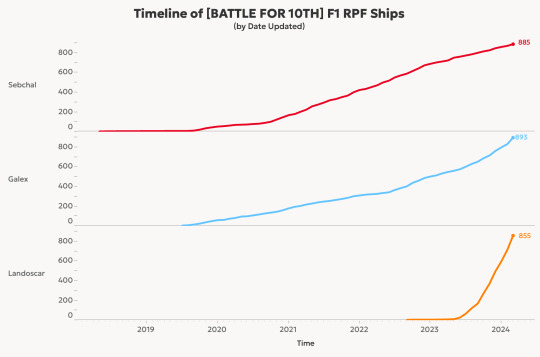

landoscar are very much on-track to surpass them and officially enter the top 10 soon, likely before mid-april ❗️ :o
ship characteristics
onto the ship content — another thing i was mildly curious about was how landoscar differs in certain areas from other f1 ships, or the f1 rpf "global" average you could say. for example, here's a breakdown of rating popularity in their ao3 tag:

seeing as explicit is their most common rating, and that i don't necessarily expect this to be true for all ships/fandoms, i compared these percentages with the general f1 rpf tag to see whether some ratings are more commonly represented in 814 fic than average, which produced interesting results:

do lando ships simply skew more HornyTM in general? is it oscar? a secret third thing??? who knows... actually i think it would be fun to do more analysis in this direction but that can wait for another time!!!
similarly i also wanted to see which ships are the most "public" on ao3, as in have the highest share of fic that isn't user-locked... i will refrain from peppering in my feelings about the 4th wall too heavy-handedly but i was curious to see whether some sort of perhaps... er, generational gap (?) of sorts between ships that are more public vs. not could be identified. however i don't pretend to have any takeaways from this LOL i conclude absolutely nothing. (for ref landoscar is currently 72% public, vs. a global avg of 63%)
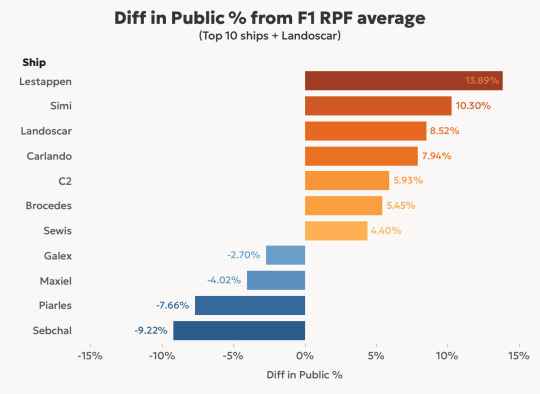
note that this graph is current stats, not filtered for 2023
looking at relationship tags, i also wanted to know whether landoscar suffer noticeably from Second-Ship Syndrome, so i tallied the first-tagged ship of every fic to find out. i know this doesn't necessarily mean that it's always the "main" ship but it's a good enough approximation. the results were quite positive!
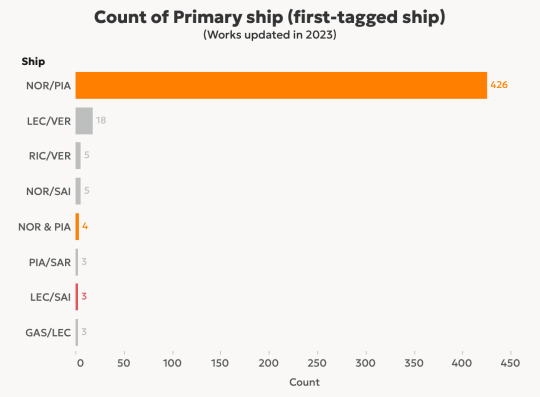
filtered to top ships with count of >1 only
i then also calculated the number of ships tagged for each fic to discern the profile of multi-shipping in 814 ficdom; i did have to do a little bit of string standardization (all instances of implied / background / hinted collapsed to hinted for simplicity's sake + removal of other redundancies), but otherwise i left everything mostly untouched.
as you can see, landoscar also have a fairly promising amount of OTP: TRUE fic:
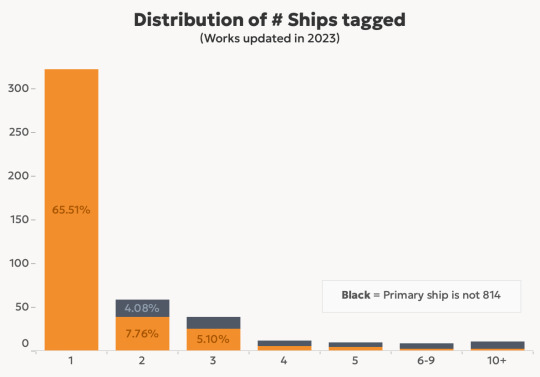
by the time you get to the fics with 10+ ships tagged, landoscar are less likely to be the primary ship, which makes sense just on a basic statistical level... this is also a very small sample size though
i also lazily tallied the 10 most common ships that weren't NOR/PIA or NOR & PIA to diff their shares of the 814 tag vs. of the general f1 rpf tag, to see which other pairings are more represented in the 814 tag than on average (because lestappen are the most popular by pure count but this is also true of fandom in general, so it would be a misrepresentation to say that their popularity is out of the ordinary):
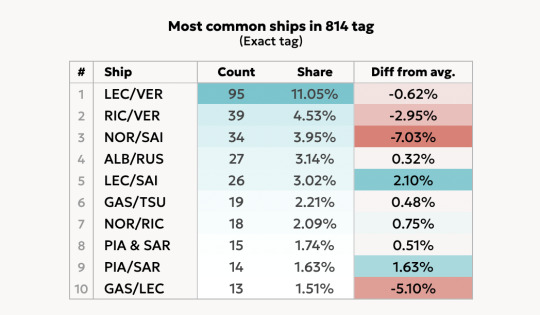
maxiel's gap isn't really that surprising since i think that, generationally, in terms of when both pairings were teammates there is quite a gap; with carlando—actually let me tally this again but including all instances of "implied" and "past" as being part of the same ship, since that's how ao3 tag-wrangles as well:
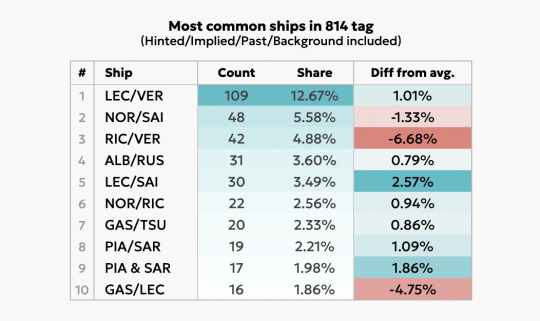
Aha ! obviously as a direct ship there is competition between 814 and other lando or oscar ships, but this difference is somewhat less pronounced once we include all formats. tbh none of this really means anything but i thought i'd add it anyway... (it's also very possible that there are several errors in this, in which case my b 😔)
before we move on to additional tags, there are a few more basic characteristics of 814 fic we can calculate. i realize i never offered an overview of Super Basic Stats, so here are a few:
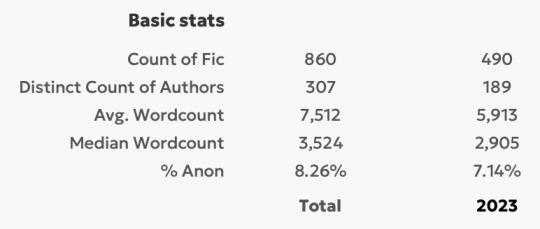
plus, looking at word counts, here is a distribution of those in 2023-updated fic, which shows that a majority of 814 fics were under the 5k mark:
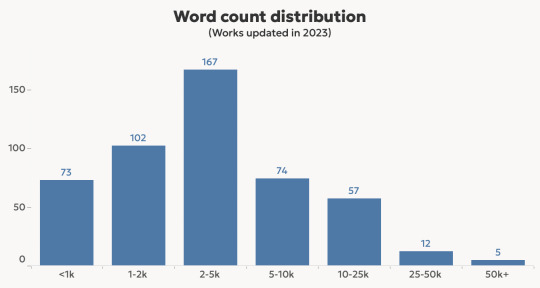
85% of landoscar fics were under 10k & nearly 97% under 25k
i don't really have any reason to believe that landoscar's wc stats differ significantly from average ? so this is kind of just Data To Have Data, and it most likely reflects normal ao3 trends in general... but i thought i'd include it anyway because i already made it lol. similarly, here are word count distributions but stratified by rating:

& same info but heat map view:
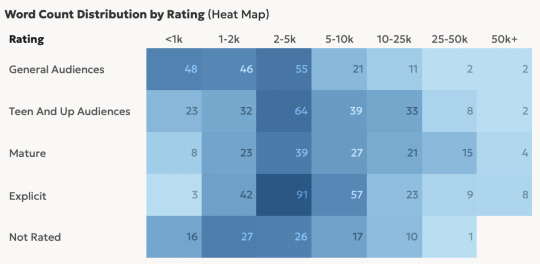
i feel like this is also probably something you'd find across fandom in general — that gen fic is likely to have a higher share of under 1k works, since Building Up to sexual content often takes... Literal & Metaphorical Foreplay ! and the longer a fic is the more opportunities an author has to include a sex scene or other explicit content (ofc, not necessarily just porn but also graphic violence & so on). but i thought this was fun to visualize haha
additional tags & aus?
back in my old f1 rpf stats post, i made a table comparing fluff/angst "ratios" (not exactly a direct ratio because of how tag wrangling works, but an approximation) of the most popular f1 ships, and now that landoscar are somewhat popular i thought i'd first do an update:
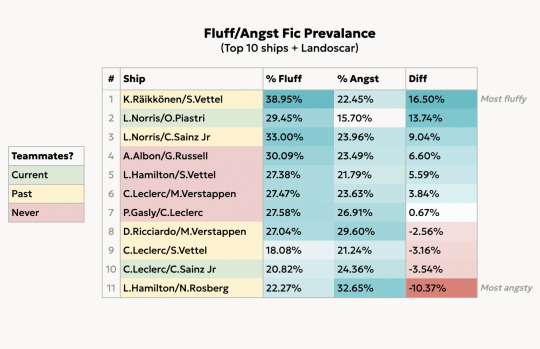
also current data, not 2023 to make things easier
just like before, simi are one of the most fluffy ships and brocedes are by far the most angsty, but it's interesting to see 814 also extremely high up on the charts, with far and away the lowest % of angst. will be exciting 2 see how that holds or changes as the seasons progress !
finally, i also wanted to do a bit of au/additional tag analysis because you can kind of see this when you use additional filters on ao3 but the previews are limited and get bogged down by the prevalence of *checks notes* Fluff, Angst, PWP, Anal Sex and what have you. which are nice stats to have and all but what of the rest !
disclaimer that the set for these tables is a biiiit outdated because by the time i'd wrangled everything i was like I Am Not Changing It Again. unfortunately i clean my data with shoddy queries and regex functions in googsheetz...
there were 48 tags with at least 10 instances from 2023 fics, shown below, with ones that are (some ~vaguely) nsfw in red just to kind of get a rough sense of which tags get commonly used in M/E fic:

getting a bit too much into small sample size / specific fic territory so if you're an author i sincerely apologize for that... do not mean 2 put u on blast... TT__TT but i also tried to tally the most popular aus people write for 814, which is a bit dubious because people tag in really different ways and i had to accommodate for a lot of string formats but ... it's close enough ! (?)
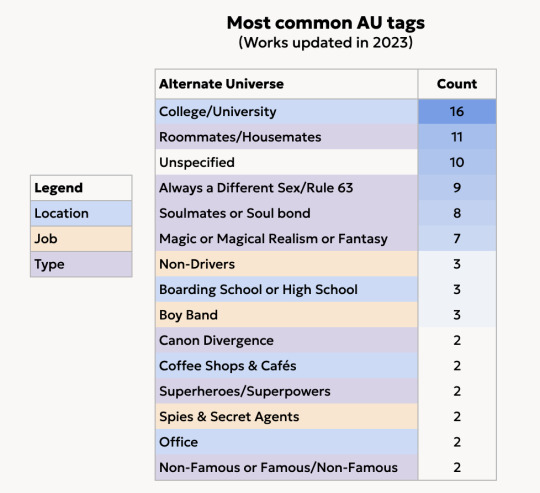
i feel like this is very little interesting info but idk what else to add so i will stop here for now... well!!! if you made it to the end i hope u learned something or even vaguely enjoyed reading T__T and most of all thank you :')
#*s#landoscar#in a sense 😔#tfw don't have a tableau license so i live life on the edge across multiple unsaved desktop public files......#if ur interested in anything specific pls lmk before my computer inevitably Dies and deletes everything...!#this is so useless nsdflshdfh. Anyway
236 notes
·
View notes
Text
Like countless other people around the globe, I stream music, and like more than six hundred million of them I mainly use Spotify. Streaming currently accounts for about eighty per cent of the American recording industry’s revenue, and in recent years Spotify’s health is often consulted as a measure for the health of the music business over all. Last spring, the International Federation of the Phonographic Industry reported global revenues of $28.6 billion, making for the ninth straight year of growth. All of this was unimaginable in the two-thousands, when the major record labels appeared poorly equipped to deal with piracy and the so-called death of physical media. On the consumer side, the story looks even rosier. Adjusted for inflation, a monthly subscription to an audio streaming service, allowing convenient access to a sizable chunk of the history of recorded music, costs much less than a single album once did. It can seem too good to be true.
Like considerably fewer people, I still buy a lot of CDs, records, and cassettes, mostly by independent artists, which is to say that I have a great deal of sympathy for how this immense reorganization in how we consume music has complicated the lives of artists trying to survive our on-demand, hyper-abundant present. Spotify divvies out some share of subscriber fees as royalties in proportion to an artist’s popularity on the platform. The service recently instituted a policy in which a track that registers fewer than a thousand streams in a twelve-month span earns no royalties at all. Some estimate that this applies to approximately two-thirds of its catalogue, or about sixty million songs. Meanwhile, during a twelve-month stretch from 2023 to 2024, Spotify announced new revenue highs, with estimates that the company is worth more than Universal and Warner combined. During the same period, its C.E.O., Daniel Ek, cashed out three hundred and forty million dollars in stock; his net worth, which fluctuates but is well into the billions, is thought to make him richer than any musician in history. Music has always been a perilous, impractical pursuit, and even sympathetic fans hope for the best value for their dollar. But if you think too deeply about what you’re paying for, and who benefits, the streaming economy can seem awfully crooked.
Although artists such as Taylor Swift and Neil Young have temporarily removed their music from Spotify—Swift pressed the company over its paltry royalty rates, while Young was protesting its nine-figure deal with the divisive podcaster Joe Rogan—defying the streamer comes with enormous risks. Spotify is a library, but it’s also a recommendation service, and its growth is fuelled by this second function, and by the company’s strategies for soundtracking the entirety of our days and nights. As a former Spotify employee once observed, the platform’s only real competitor is silence. In recent years, its attempts at studying and then adapting to our behavior have invited more than casual scrutiny among users: gripes about the constant tweaks and adjustments that make the interface more coldly opaque, stories about A.I.-generated songs and bots preying on the company’s algorithms, fatigue over “Spotify-core,” the shorthand for the limp, unobtrusive pop music that appears to be the service’s default aesthetic. Even Spotify’s popular Wrapped day, when users are given social-media-ready graphics detailing their listening habits from the past year, recently took its lumps. Where the previous year’s version assigned listeners a part of the world that most aligned with their favorites, the 2024 edition was highlighted by the introduction of personalized, A.I.-voiced recaps, striking some as the Spotify problem in a nutshell—a good thing that gets a little worse with all the desperate fine-tuning.
Just as we train Spotify’s algorithm with our likes and dislikes, the platform seems to be training us to become round-the-clock listeners. Most people don’t take issue with this—in fact, a major Spotify selling point is that it can offer you more of what you like. Liz Pelly’s new book, “Mood Machine: The Rise of Spotify and the Costs of the Perfect Playlist,” is a comprehensive look at how the company’s dominance has profoundly changed the way we listen and what we listen to. A contributing editor to The Baffler, Pelly has covered the ascent of Spotify for years, and she was an early critic of how the streaming economy relies less on delivering hit tunes than on keeping us within a narrow gradient of chill vibes. Her approach is aggressively moralistic: she is strongly influenced, she explains, by D.I.Y. spaces that attempt to bring about alternate forms of “collective culture,” rather than accept the world’s inequities as a given. She sympathizes with the plight of artists who feel adrift in the winner-take-all world of the Internet, contending with superstars like Adele or Coldplay for placement on career-making playlists and, consequently, a share of streaming revenue. But her greatest concerns are for listeners, with our expectations for newness and convenience. Pelly is a romantic, but her book isn’t an exercise in nostalgia. It’s about how we have come to view art and creativity, what it means to be an individual, and what we learn when we first hum along to a beloved pop song.
A great many people over forty retain some memory of the first time they witnessed the awesome possibilities of Internet piracy—the sense of wonder that you could go to class and return a couple of hours later to a Paul Oakenfold track playing from somewhere inside your computer. In 1999, two teen-agers named Shawn Fanning and Sean Parker launched the file-sharing application Napster, effectively torching the music industry as it had existed for nearly a century. There had always been piracy and bootlegging, but Napster introduced the free exchange of music at a global scale. Rather than maintain a publicly accessible archive of recordings—which was clearly illegal—Napster provided a peer-to-peer service that essentially allowed users to pool their music libraries. After a year, Fanning and Parker’s app had twenty million users.
At first, anti-Napster sentiment echoed the hysteria of the nineteen-seventies and eighties around the prospect of home taping killing the record industry. Yet online piracy was far more serious, moving at unprecedented speed. One label executive argued that Fanning and Parker belonged in jail, but there was no uniform response. For example, the media conglomerate Bertelsmann made plans to invest in Napster even as it was suing the company for copyright infringement. Some artists embraced Napster as a promotional tool. Chuck D, of Public Enemy, published a Times Op-Ed in which he praised Napster as “a new kind of radio.” The punk band the Offspring expressed its admiration by selling bootleg merchandise with the company’s logo. On the other side was the heavy-metal band Metallica, which sued the platform for “trafficking in stolen goods,” and thereby became seen—by many of their fellow-musicians as well as by listeners—as an establishment villain. Faced with too many legal challenges, Napster shut down in July, 2001. But the desire to break from traditional means of disseminating culture remained, as casual consumers began imagining an alternative to brick-and-mortar shopping and, with it, physical media. Just four months after Napster’s closure, Apple came out with the iPod.
In Sweden, where citizens had enjoyed high-speed Internet since the late nineties, piracy took on a political edge. In 2001, after a major anti-globalization protest in Gothenburg was violently put down by the police, activists formed online communities. In 2003, Rasmus Fleischer helped found Piratbyrån, or the Pirate Bureau, a group committed to flouting copyright laws. “We were trying to make something political from the already existing practice of file-sharing,” Fleischer explained to Pelly. “What are the alternative ways to think about power over networks? What counts as art and what counts as legitimate ways of using it? Or distributing money?” That year, a group of programmers associated with Piratbyrån launched the Pirate Bay, a file-sharing site that felt like a more evolved version of Napster, allowing users to swap not only music but movies, software, and video games.
Alongside Pirate Bay, file-sharing applications like LimeWire, Kazaa, and Grokster emerged to fill Napster’s void and were summarily targeted by the recording industry. Meanwhile, the music business marched forward, absorbing losses and deferring any hard decisions. So long as fans still thought of music in terms of ownership, there were still things to sell them—if not physical media, at least song files meant to be downloaded onto your hard drive. The most common model in the United States was the highly successful iTunes Store, which allowed listeners to purchase both albums and single tracks, abiding by a rough dollar-per-song value inherited from the age of LPs and CDs. “People want to own their music,” Steve Jobs said, in 2007, claiming he’d seen no evidence that consumers wanted a subscription model. “There’s definitely a hurdle with subscription because it’s not an exact replica of the model people are used to in the physical world,” Rob Williams, an executive at Rhapsody, one of the largest early-two-thousands music-subscription services, observed, in 2008.
Daniel Ek, Spotify’s C.E.O., taught himself programming as a teen-ager in Stockholm and was financially secure by his mid-twenties, when he began looking for a new project to work on. Like many, he credits Napster for providing him with a musical education. While some of his countrymen saw piracy as anarchist, a strike against big business, Ek sensed a more moderate path. He and Martin Lorentzon, both well versed in search engines and online advertising, founded Spotify, in 2006, in the hope of working with the music industry, not against it. Ek explained to a reporter, in 2010, that it was impossible to “legislate away from piracy.” The solution was making an alternative that was just as convenient, if not more. The year he and Lorentzon launched Spotify, the census showed that thirteen per cent of Sweden’s citizens already participated in file-sharing. “I’m just interested in building a company that doesn’t necessarily change lives but adapts people’s behavior,” Ek said.
Spotify benefitted from the emergence of smartphones and cheap data plans. When we are basically never offline, it no longer matters where our files are situated. “We’re punks,” Ek said. “Not the punks that are up to no good. The punks that are against the establishment. We want to bring music to every person on the face of the planet.” (Olof Dreijer, of the Swedish electronic pop group the Knife, griped to Pelly that the involvement of tech companies in music streaming represented the “gentrification” of piracy.)
Spotify made headway in Europe in the twenty-tens, capitalizing on the major labels’ seeming apathy toward committing to an online presence. It began offering plans to U.S. users in 2011—two paid tiers with no ads and a free one that, as an analyst told the Times that year, was “solidifying a perception that music should be free.” Ek sought partnerships with major labels, some of which still own Spotify stock. Around this time, a source who was then close to the company told Pelly, Spotify commissioned a study tracking the listening habits of a small subset of users and concluded that it could offer a qualitatively different experience than a marketplace like iTunes. By tracking what people wanted to hear at certain hours—from an aggro morning-workout mix to mellow soundscapes for the evening—the service began understanding how listeners used music throughout the day. People even streamed music while they were sleeping.
With all this information, Spotify might be able to guess your mood based on what time it was and what you had been listening to. Pelly argues, in fact, that its greatest innovation has been its grasp of affect, how we turned to music to hype us up or calm us down, help us focus on our homework or simply dissociate. Unlike a record label, a tech company doesn’t care whether we’re hooked on the same hit on repeat or lost in a three-hour ambient loop, so long as we’re listening to something. (This helps explain its ambitious entry into the world of podcasting, lavishing nine-figure deals on Joe Rogan and on the Ringer, Bill Simmons’s media company, as well as its recent investment in audiobooks.) Spotify just wants as much of our time and attention as possible, and a steady stream of melodic, unobtrusive sounds could be the best way to appeal to a passive listener. You get tired of the hit song after a while, whereas you might stop noticing the ambient background music altogether.
Last spring, a Swedish newspaper published a story about a little-known hitmaker named Johan Röhr, a specialist in tepid, soothing soundscapes. As of March, Röhr had used six hundred and fifty aliases (including Adelmar Borrego and Mingmei Hsueh) to release more than twenty-seven hundred songs on Spotify, where they had been streamed more than fifteen billion times. These numbers make him one of the most popular musicians in the world, even though he is not popular in any meaningful sense—it’s doubtful that many people who stream his music have any idea who he is. Spotify’s officially curated playlists seem to be a shortcut to success, akin to songs getting into heavy rotation on the radio or television. Röhr has benefitted from being featured on more than a hundred of them, with names like “Peaceful Piano” or “Stress Relief.” His ascent has raised a philosophical question about music in the streaming age: Does it even matter who is making this stuff? At least Röhr’s a real person. What about A.I.-generated music, which is increasingly popular on YouTube?
It’s tricky to make the argument that any of this is inherently bad for music fans; in our anti-élitist times, all taste is regarded as relative. Maybe Johan Röhr does, indeed, lower your stress levels. Who’s to say that A.I. Oasis is that much better or worse than the real thing? If you harbor no dreams of making money off your music, it’s never been easier to put your art out into the world. And even if we are constructing our playlists for friends under “data-tuned, ultra-surveilled” circumstances, feeding a machine data to more effectively sell things back to us, it’s a trade that most users don’t mind making. We’ve been conditioned to want hyper-personalization from our digital surroundings, with convenience and customizable environments the spoils of our age. For Pelly, it’s a problem less of taste than of autonomy—the question she asks is if we’re making actual decisions or simply letting the platform shape our behaviors. Decades ago, when you were listening to the radio or watching MTV, you might encounter something different and unknown, prompting some judgment as to whether you liked or loathed it. The collection of so much personalized data—around what time of day we turn to Sade or how many seconds of a NewJeans song we play—suggests a future without risk, one in which we will never be exposed to anything we may not want to hear.
Spotify recently projected that 2024 would be its first full year of profitability; one investment analyst told Axios that the company had “reached a level of scale and importance that we think the labels would be engaging in mutually-assured devastation if they tried to drive too hard a bargain.” Its success seems to have derived partly from cost-cutting measures: in December, 2023, it eliminated seventeen per cent of its employees, or about fifteen hundred jobs. Some music-industry groups also say that Spotify has found a way to pay less to rights holders by capitalizing on a 2022 ruling by the Copyright Royalty Board which allows services bundling different forms of content to pay lower rates.
I wonder if any of Pelly’s arguments will inspire readers to cancel their subscriptions. I remain on my family’s Spotify plan; it’s a necessary evil when part of your job involves listening to music. For all the service’s conveniences, one of my frustrations has always been the meagre amount of information displayed on each artist’s page, and Pelly’s criticisms made me think this might be by design—a way of rendering the labor of music-making invisible. Except for a brief biographical sketch, sounds float largely free of context or lineage. It’s harder than it should be to locate a piece of music in its original setting. Instead of a connection to history, we’re offered recommendations based on what other people listened to next. I’ve never heard so much music online as I have over the past few years yet felt so disconnected from its sources.
In 2020, Ek warned that “some artists that used to do well in the past may not do well in this future landscape where you can’t record music once every three to four years and think that’s going to be enough.” Rather, he suggested, artists would have to adapt to the relentless rhythms of the streaming age. I’ve long been fascinated by musicians who explore the creative tension between their own vision and the demands of their corporate overlords, making music in playful, mocking resistance of the business. A personal favorite is R.A. the Rugged Man’s “Every Record Label Sucks Dick,” which has been streamed about a quarter of a million times. Although I’ve heard many artists lament Spotify’s effect on their livelihoods, it’s hard to imagine someone channelling that animosity into a diss track. For that matter, it’s a conversation I rarely hear on podcasts—the chances of finding an audience without being present on the world’s largest distributor are slim. Instead, artists make music about the constant pressures of fame, as Tyler, the Creator, did with 2024’s “Chromakopia.” Or they try in vain to protect themselves from it, as the singer Chappell Roan, known for her theatrical take on dance pop, did this past summer. One of the breakout stars of 2024, Roan had difficulty coping with the unyielding demands of her sudden superstardom, eventually posting a TikTok begging her fans to respect her personal boundaries. The targets within the industry were once varied and diffuse, but they were identifiable. Now the pressure comes from everywhere, leaving artists to exploit themselves.
Reading “Mood Machine,” I began to regard Spotify as an allegory for life this year—this feeling that everything has never been so convenient, or so utterly precarious. I’d seldom considered the speed at which food or merchandise is delivered to my house to be a problem that required a solution. But we acclimate to the new normal very quickly; that is why it’s hard to imagine an alternative to Spotify. Rival streaming services like Apple Music deliver slightly better royalties to artists, yet decamping from Spotify feels a bit like leaving Twitter for Bluesky in that you haven’t fully removed yourself from the problem. Digital marketplaces such as Bandcamp and Nina offer models for directly supporting artists, but their catalogues seem niche by comparison.
In the past few years, artists have been using the occasion of Spotify’s Wrapped to share how little they were paid for the year’s streams. The United Musicians and Allied Workers, a music-industry trade union, was formed in 2020 in part to lobby on behalf of those most affected by the large-scale changes of the past decade. Four years later, Representatives Rashida Tlaib and Jamaal Bowman introduced the Living Wage for Musicians Act, which would create a fund to pay artists a minimum of a penny per stream. With a royalty rate at around half a cent—slightly more than Spotify pays—it would take more than four hundred and eighty thousand streams per month to make the equivalent of a fifteen-dollar-an-hour job. But the bill hasn’t made any legislative playlists.
Earlier this year, responding to questions about Spotify’s effect on working musicians, Ek compared the music industry to professional sports: “If you take football, it’s played by hundreds of millions of people around the world. But there’s a very, very small number of people that can live off playing soccer full time.” The Internet was supposed to free artists from the monoculture, providing the conditions for music to circulate in a democratic, decentralized way. To some extent, this has happened: we have easy access to more novelty and obscure sounds than ever before. But we also have data-verified imperatives around song structure and how to keep listeners hooked, and that has created more pressure to craft aggressively catchy intros and to make songs with maximum “replay value.” Before, it was impossible to know how many times you listened to your favorite song; what mattered was that you’d chosen to buy it and bring it into your home. What we have now is a perverse, frictionless vision for art, where a song stays on repeat not because it’s our new favorite but because it’s just pleasant enough to ignore. The most meaningful songs of my life, though, aren’t always ones I can listen to over and over. They’re there when I need them.
Pelly writes of some artists, in search of viral fame, who surreptitiously use social media to effectively beta test melodies and motifs, basically putting together songs via crowdsourcing. Artists have always fretted about the pressure to conform, but the data-driven, music-as-content era feels different. “You are a Spotify employee at that point,” Daniel Lopatin, who makes abstract electronic music as Oneohtrix Point Never, told Pelly. “If your art practice is so ingrained in the brutal reality that Spotify has outlined for all of us, then what is the music that you’re not making? What does the music you’re not making sound like?” Listeners might wonder something similar. What does the music we’re not hearing sound like?
22 notes
·
View notes
Text
CNC Hypnosis 6000 Users Demographics
Back on September 29th, CNC Hypnosis reached the 6000 users milestone. As per the usual, I grabbed the number of users from a couple of the assignable roles to make some graphs. These roles are not mandatory for anyone who joins the server, but they give us a generalized picture of what types of users our server has!
Join me after the jump for details
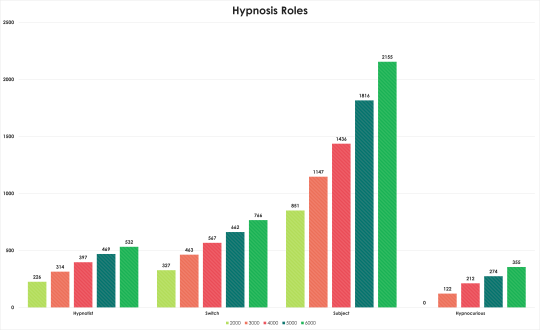
First up today, we have the hypnosis roles, 3808 of our members have hypnosis roles. The role that had the most growth since 5000 members is Hypnocurious, with a growth rate of 29%. Hypnocurious members are currently 9.23% of our server and in case you were wondering, Hypnotists are 13.97% of the server.
(Note that the Hypnocurious role was added after reaching 2000 users)
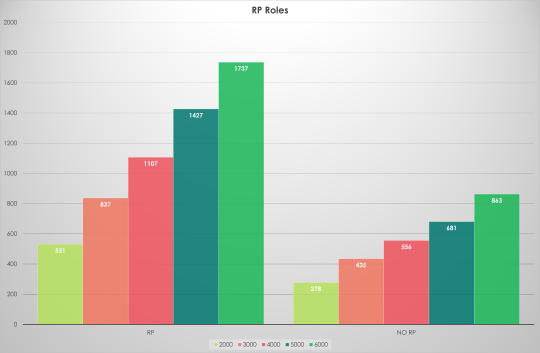
Next on the list are the RP Roles. 2600 users have these roles. RP is obviously the more popular role, but No RP is increasing its percentage of users. 66.81% of users have the RP role and 33.19% of users have the No RP role.
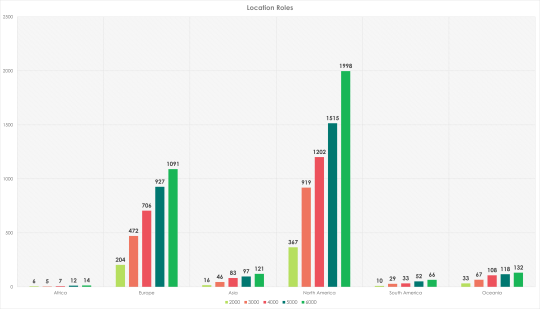
The Location roles are next, and 3422 users have these roles. North America remains the most popular with 1998 members and 58.39% of all users choosing this role. All location roles saw growth since last time, but South America had the second highest growth percentage since 5000 users. Hola!

We’re at age roles now, 3583 users have these roles. The age range with the most growth? 30+ which grew 23.28%. The 18+ role still outnumbers everyone here with 1175 users (32.79% of all) but 21+ approaches slowly with 919 users (25.65% of all).
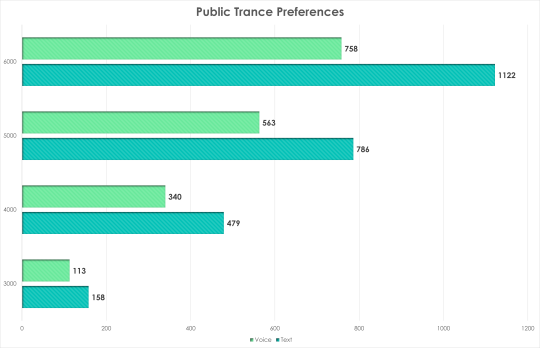
Then there are the public trance roles, unlike the previous roles, users can pick more than one of these. 1880 roles have been chosen in this section. Text trances are the most popular in the server with 59.68% choosing that role and it also grew the most with a 42.75% growth rate.
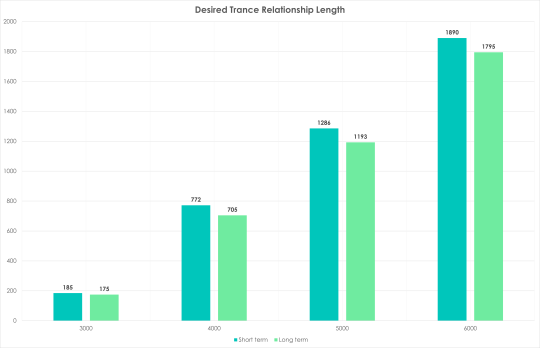
Finally, we have desired trance relationship. Just like the public trance roles, users can pick more than one of these. These roles were chosen 3685 times. This is the closest percentage wise on what people desire. 51.29% choose short term trances and 48.71% choose long term trances.
Wanna help us with our next set of demographics? Join CNC Hypnosis today and grab roles in our role channel!
14 notes
·
View notes
Text
The Short Patreon Breakdown
Basic version of this post, for people with no attention span. For details on each of these points, please see the original post.
1. The iOS processing fees are a smokescreen covering up the actual devastating changes that Patreon is forcing creators into—including doing away with the two billing models used by most of the highest-earning creators on the platform, regardless of the impact this will have on their livelihood.
2. Patreon is not going to change course for any reason. This is set in stone. CEO Jack Conte himself has been having one-on-one meetings and calls with the platform's top earners, and clearly has no interest in their actual grievances or how their businesses operate—only in getting them to stop complaining.
3. Patreon has offered no proof of their claims that the iOS app is responsible for 40 percent of the engagement on the platform—and also refuse to define what "engagement" means. Staff rebuff all requests for detailed analytics or data on the revenue share coming from the app, but did not refute the possibility that dismissing an app notification counted as "engagement."
4. Patreon does not have a refund policy in place to work with Apple in order to protect creators from malicious chargebacks, and has given no indication of any intent to work with Apple to shorten the time it takes for funds from iOS purchases to be paid out to creators—which is currently 75 days.
5. Patreon's own graphics meant to explain why this is necessary and how the new fees work are not correct: the fee structure graphic features a copying error that results in incorrect math, and adding together everything on the bar graph showing the daily active users by avenue of access comes to a total of 103 percent. They are woefully unprepared to share this information, and are putting it on us for "not understanding."
6. Patreon refuses to offer any promises to 18+ creators that they will not be removed from the app in order to adhere to Apple's content guidelines, instead only saying they currently have no plans to remove us from the app. Questioning this was met with a reminder that they've had to change the TOS for 18+ creators before.
7. All the features Patreon is insisting are integral for creator growth are inaccessible to 18+ creators, and questions about this were either dismissed, redirected, or ignored. 18+ creators can't even be found on either app, but we're being forced to cater to iOS' terms anyway, with claims that it's because all creators need the app in order to grow. Even though we can't utilize it.
8. Patreon's iOS app is currently* in violation of Apple's guidelines for app ratings; staff did not state any intention to become compliant by raising the app's rating as needed to maintain their 18+ creator community, only declaring that they're "exploring options." Per Apple's guidelines, the "options" are to either raise the rating to 17+, cutting off access for the wealthy teenagers with iPhones to which the platform is so dedicated they'll kneecap their top earner in order to court, or kick all 18+ creators off the platform. (This includes horror, true crime, health, trauma recovery, and more, not just sexual content.) *Current as of August 18, 2024.
Do not let the 30 percent App Store fee distract you from what's really going on here. Patreon is crippling a huge portion of their creators, including a horde of their top earners—and the single most profitable creator on the entire platform—and offering no legitimate reasons why. The amount of money they're losing from these creators restructuring or leaving altogether totals in the millions within a single month of activity. This isn't even about money, it's about something else—and there's no way to know what, because Patreon is giving us nothing.
#patreon#apple#ios app#app store#patreon fees#patreon billing#PSA#creators on tumblr#artists on tumblr#writers on tumblr#please signal boost this if you can
28 notes
·
View notes
Text
Hisoka and greed Island
One of the accusations levied against Togashi as a writer and Hisoka as a character is his inconisistant characterization.
He teams up with the protaganists, avoids conflicts with those on greed island, and generally behaves "strangely" during greed island. Lets talk about that.
First, lets talk goals.
Hisoka is primarily interested in fighting strong people, not just that, in this moment he is coming off of trying to fight Chrollo and being denied. Chrollo losing his nen to Kurapika removes him as currently viable target to enjoy fighting
He has spent several years attempting to set up a fight with Chrollo, dreaming specifically of a 1 on 1 conflict where the spiders will not interfere to protect their leader. He joined the spiders, fought in heaven's arena and joined the Greed Island game all in an attempt to set up this meeting.
While he's on the island, the specific events taking place are of very little interest to him, beyond meeting an exorcist able to remove Kurapika's curse and fight Chrollo in exchange.
Now that we have the groundwork set, lets talk about specific opponents Hisoka chooses not to fight by the order he meets them.
1. Bisky
The primary reason Hisoka chooses not to fight Bisky is her ability. Mostly, her ability is to hide her physical and magical capacity from viewers. This is an interesting portion of nen user's primary focus. Frankily, it would be a pain in the ass to fight violence obsessed pedophiles everytime you go for groceries. Ging does something similar, using a stand-in and avoiding being near the majority hunters during the election.
The secondary reasoning is that she is training Gon and Killua. They won't be "ripe" by the time she's done training them here, but after she trains them again during the Chimera Ant Arc, Hisoka decides Killua is ripe enough to kill. Fighting her here would severly hamper their growth rate.
2. Razor
Hisoka decides not to fight razor, instead focusing on... beating him at volleyball?
This is, I believe, for a very simple reason: Hisoka wants to avoid getting kicked off the island. If pressed, it's likely Razor would evoke a Game Master card, sending Hisoka off the island at best, making him unable to fight Chrollo.
The other reason, though this is more headcanon, is that he realizes something Gon does not; A lot of Razor's nen is tied up in greed island. 7 devils is, unlike many of the nen master abilities we see, pretty weak, limited and small scale. When compared to White Gorenue and Black Gorenue, it also offers less utlity. The most comparable ability is Tocino's 11 Black Children, which... that guy died in 2 seconds against Franklin, someone generally beneath Hisoka's interest.
Razor mentions, somewhat casually, that he handles the emmsive systems for the game. This includes teleporting players from an unspecified distance to Greed Island, spell projectiles and a million other things. This sounds like it would eat up a large portion of his "memory" as Hisoka calls it, leaving him with only enough power for 7 devils.
#hxh#hunterxhunter#everything I have to say is stupid and obvious.#anyway thinking about abengane now
15 notes
·
View notes
Text
a big reason why i personally respond very strongly and publicly about internet censorship bills is because every tool and support ive ever had to understand my trauma, cope with my mental health issues, historically contextualize my experiences, and become a somewhat functional adult, were all found online. the friends who support me found me online. my ability to do my art business & be my authentic self in the same place at the same time is thanks to the expressive powers of the internet. almost nothing good in my life would have been possible if there was legislation like KOSA enacted when i was a child. which is why i have been openly speaking out against legislation like this ever since i was a child.
one example of the problem here is that the heritage foundation intends to use KOSA as a way to sue websites into censoring information about LGBT+ issues and sex/reproductive health. they said it publicly, and i have no reason to think they’re bluffing. the heritage foundation is also the main party behind Project 2025 (an authoritarian agenda for the U.S. political right published and free to read online). they should be taken seriously because they have proudly played a massive role in deciding what Republican public policy be will be since the Reagan administration. if you are politically active online at all and don’t know whether your most dearly held causes are under threat by this group, type “the heritage foundation’s stance on” into your favorite search engine, take a look at the recommended searches, and get ready to have a very bad time. (…unless you’re one of those rare far-right political users on this site, in which case you’d probably have a pretty good time)
this is happening alongside the recent growth of the “parental rights” movement, whose achievements include promoting book bans, trying to suppress any information they deem to be “Critical Race Theory”, as well as harassing and threatening people for supporting LGBT+ kids. they aim to silence any voices that don’t fall in line with their agenda. moms for liberty is a prominent example of a harmful “parental rights” activist group; they have repeatedly done things like this. i have no doubt that these groups would absolutely utilize KOSA to further prevent children from accessing important educational information.
Rep. Marsha Blackburn, the one of the two legislators who has spearheaded the push to pass this bill through the Senate, is a self identified “hard-core” “politically incorrect” conservative who came into the Senate during the Trump administration. She is also part of the larger Tennesseean right-wing political apparatus that has brought this state wonders like cities where public homosexuality is illegal, and a county where the juvenile detention rate approaches 50%. these people do not care about the wellbeing of children. they are doing awful things here that the majority of tennesseans do not support. there are many other recent, infamous examples of similar state and local human rights failures throughout the US. if you let them have their way, these post-Trump Republicans will do their best to bring this kind of nonsensical, authoritarian governance to the entire country and potentially the rest of the world, given the role that U.S. law plays in the reality of the international internet.
i have been mostly sharing others’ posts and contacting legislators on my own time, but on December 6th, a letter was published in support of KOSA that was signed by 200 organizations— largely mental health and childrens’ health related groups. i believe that far-right political groups will use KOSA to silence the kind of online information that helped me with my own mental health when i was a kid, and that kids are currently relying on today. ultimately, i think it is a shame that these 200 organizations think they can get away with publicly supporting a bill that is so widely criticized and politically fraught.
18 notes
·
View notes
Text
As of now, we have over 100 games available for our users. Our titles range from first-person shooters to action-adventure games and everything in between. Our analytics show that our users have an average playtime of 3 hours per day, with a 90% engagement rate. Our followers and likes are steadily increasing, and we expect to see significant growth in the coming months. Our projections for 2025 indicate that we will earn over $2 billion in revenue. Our launch date is set for August 2024, and analysts have estimated that we will be one of the most successful gaming devices in history.
Our focus on user experience and innovation has also been critical to our success. We have developed a user-friendly interface that allows gamers to easily navigate our platform and find the games they want to play. We also offer a range of customization options, allowing users to personalize their gaming experience. Additionally, we have implemented a rewards system that incentivizes players to engage with our platform and participate in our community. These features have helped us to create a loyal and engaged user base, which has been instrumental in our growth.
Our commitment to innovation doesn't end there. We are constantly working to improve our platform and add new features that will enhance the gaming experience. For example, we are currently developing a new social feature that will allow users to interact with each other in real-time, as well as a new system for sharing game content. We also plan to release a mobile app that will allow users to access our platform from their phones or tablets. These updates will make our platform more accessible and user-friendly, further cementing our position as a leader in the gaming industry.
#playstation7#deardearestbrands#ps7#framework#digitalconsole#celestiallink#python#Playatation7App#PS7app#Application
3 notes
·
View notes
Text
Space Station Concepts: Power Tower

"It would provide maximized user viewing opportunities, a clear area for Shuttle dockings and versatility in Station growth. The design was also less sensitive to changes in mass caused by the addition of modules to the Station. The 'Power Tower' station's main structure was to be 122 meters tall with 75 kW solar panels sticking 41 meters to either side of the centerline.

"This is an artist's conception of the proposed 'Power Tower' space station configuration, shown with the Japanese Experiment Module attached. This model and several others were examined before deciding on the Space Station Freedom structure that was later abandoned in favor of the International Space Station. Date: June 19, 1985."
There were nine articulated attachments for external payloads dedicated to Earth and space observation. The initial Station would have had a crew of six working on 12-hour shifts, and feature two US-developed laboratory modules plus two habitation modules.

A maximum of 18 hours/week of EVA 'spacewalks' would be permitted per astronaut. International modules had not yet been incorporated in the design. The 'Power Tower' assembly schedule would have required 12 Shuttle flights over a three-year period, starting in April 1992. The Space Station would support research in a man-tended capability from April 1993 onwards. But the schedule was already starting to slip as the Office of Management and Budget reduced the Fiscal 1985 budget from $235 million to $150 million. The slight reduction increased the total cost to $8.1 billion at 1984 rates ($11.4 billion in current-year dollars).


Some observers were critical of the contractors' lack of independent involvement in the design process. They felt Station contractors did nothing but ape NASA's configurations in order to win the contract. In May 1987, former Space Station engineer Oliver Harwood testified in the Senate. 'Aerospace industry resources and capabilities were being squandered by 'rubber stamping' NASA designs instead of seeking independent and competitive solutions to system problems. Why were the artist's conceptions of eight major corporations so nearly identical? In a real competition seeking real answers there would be a different version for each of them.'


NASA allocated all Space Station definition work between four 'Work Packages' managed by its Johnson, Marshall, Goddard and Lewis Space Centers in July 1984. Work Package 4, led by the Lewis Research Center, would investigate Space Station power options. The two leading contenders were photovoltaic solar arrays and solar thermodynamic generators. Solar thermodynamic generators would use huge parabolic dishes to heat a fluid, which then powered electric generators. They were more efficient than traditional photovoltaic solar panels, had a longer lifetime and generated less atmospheric drag. But they also had to be pointed to within 1.5 degrees of the Sun to generate electricity, and the concept had never been tried before. NASA awarded contracts worth a combined $144 million to six contractor teams in April 1985, including $20 million to Work Package 4 contractors TRW and Lockheed. The agency still had not decided whether solar thermodynamic generators or photovoltaic arrays would be chosen. Another concept from the late 1980s would generate auxiliary power from the Earth's magnetic field by connecting a generator to a long electrically conducting tether. The other end was attached to the Space Station.


The McDonnell-Douglas 'Power Tower' Space Station crew modules were 10.7 meters long with docking ports at both ends. They would have been assembled end-to-end in a racetrack-like configuration. Some engineers felt this could have created dangerous dead-ends inside the Station if a module had to be depressurized. The contractors paid considerable attention to habitability issues since each crew would live and work on the Space Station for 90 days before returning to Earth. Rockwell's crew module proposal put all the equipment inside storage racks in the middle of the module rather than on the walls.
Article by Marcus Lindroos"
-Information from astronautix.com: link
NASA ID: 85-H-273
source, source, source
Mike Acs's Collection: link
NASA ID: C-1984-5784
SDASM Archives: 54059800
#Power Tower Space Station#Power Tower#Space Station Freedom#Space Station Concept#Space Station#Concept Art#NASA#Space#Earth
31 notes
·
View notes
Text
AI & Data Centers vs Water + Energy

We all know that AI has issues, including energy and water consumption. But these fields are still young and lots of research is looking into making them more efficient. Remember, most technologies tend to suck when they first come out.
Deploying high-performance, energy-efficient AI
"You give up that kind of amazing general purpose use like when you're using ChatGPT-4 and you can ask it everything from 17th century Italian poetry to quantum mechanics, if you narrow your range, these smaller models can give you equivalent or better kind of capability, but at a tiny fraction of the energy consumption," says Ball."...
"I think liquid cooling is probably one of the most important low hanging fruit opportunities... So if you move a data center to a fully liquid cooled solution, this is an opportunity of around 30% of energy consumption, which is sort of a wow number.... There's more upfront costs, but actually it saves money in the long run... One of the other benefits of liquid cooling is we get out of the business of evaporating water for cooling...
The other opportunity you mentioned was density and bringing higher and higher density of computing has been the trend for decades. That is effectively what Moore's Law has been pushing us forward... [i.e. chips rate of improvement is faster than their energy need growths. This means each year chips are capable of doing more calculations with less energy. - RCS] ... So the energy savings there is substantial, not just because those chips are very, very efficient, but because the amount of networking equipment and ancillary things around those systems is a lot less because you're using those resources more efficiently with those very high dense components"
New tools are available to help reduce the energy that AI models devour
"The trade-off for capping power is increasing task time — GPUs will take about 3 percent longer to complete a task, an increase Gadepally says is "barely noticeable" considering that models are often trained over days or even months... Side benefits have arisen, too. Since putting power constraints in place, the GPUs on LLSC supercomputers have been running about 30 degrees Fahrenheit cooler and at a more consistent temperature, reducing stress on the cooling system. Running the hardware cooler can potentially also increase reliability and service lifetime. They can now consider delaying the purchase of new hardware — reducing the center's "embodied carbon," or the emissions created through the manufacturing of equipment — until the efficiencies gained by using new hardware offset this aspect of the carbon footprint. They're also finding ways to cut down on cooling needs by strategically scheduling jobs to run at night and during the winter months."
AI just got 100-fold more energy efficient
Northwestern University engineers have developed a new nanoelectronic device that can perform accurate machine-learning classification tasks in the most energy-efficient manner yet. Using 100-fold less energy than current technologies...
“Today, most sensors collect data and then send it to the cloud, where the analysis occurs on energy-hungry servers before the results are finally sent back to the user,” said Northwestern’s Mark C. Hersam, the study’s senior author. “This approach is incredibly expensive, consumes significant energy and adds a time delay...
For current silicon-based technologies to categorize data from large sets like ECGs, it takes more than 100 transistors — each requiring its own energy to run. But Northwestern’s nanoelectronic device can perform the same machine-learning classification with just two devices. By reducing the number of devices, the researchers drastically reduced power consumption and developed a much smaller device that can be integrated into a standard wearable gadget."
Researchers develop state-of-the-art device to make artificial intelligence more energy efficient
""This work is the first experimental demonstration of CRAM, where the data can be processed entirely within the memory array without the need to leave the grid where a computer stores information,"...
According to the new paper's authors, a CRAM-based machine learning inference accelerator is estimated to achieve an improvement on the order of 1,000. Another example showed an energy savings of 2,500 and 1,700 times compared to traditional methods"
4 notes
·
View notes
Text
Expert Website Developer in Dubai: Building Custom Solutions for Your Business Success
In the heart of the Middle East, where innovation meets tradition, businesses are continuously seeking ways to stand out in a crowded marketplace. As digital presence becomes paramount for success, enlisting an expert website developer in Dubai has never been more crucial. Imagine a tailored online platform that not only reflects your brand's identity but also engages customers and drives conversions—this is where specialized web development comes into play. With a bustling economy and a tech-savvy populace, Dubai offers limitless opportunities for local entrepreneurs and global companies alike.

Importance of Custom Solutions for Businesses
In today’s rapidly evolving business landscape, the importance of custom solutions cannot be overstated. Off-the-shelf software might initially seem cost-effective, but it often fails to address the unique challenges and objectives that individual companies face. By investing in tailored solutions, businesses can optimize their operations, enhance customer experiences, and ultimately drive growth more effectively. For instance, a skilled website developer in Dubai can create bespoke platforms that align perfectly with local market needs and cultural nuances, ensuring better engagement and conversion rates.
Moreover, custom solutions provide scalability that standard products simply can't match. As businesses expand or adapt to new market trends, a flexible system designed specifically for their workflows can easily grow alongside them. This adaptability extends not just to features but also to integration capabilities with existing technologies—vital for maintaining a cohesive operational framework. Harnessing the expertise of a proficient website developer in Dubai means harnessing innovation that’s not just current but anticipatory of future demands, giving firms a competitive edge built on responsiveness rather than reactive adjustments. Such foresight is critical as businesses navigate an ever-changing digital terrain where agility is key to survival and success.
Key Features of Successful Websites
A successful website is often characterized by its user-centric design and seamless navigation. One of the key features that sets high-performing websites apart is their ability to engage visitors quickly through intuitive layouts and visual hierarchy. Elements such as clear call-to-action buttons, responsive design, and well-organized content ensure that users can effortlessly find the information they seek. A website developer in Dubai understands that optimizing for mobile devices is crucial in today's digital landscape, where an increasing number of users browse on smartphones.
Another essential aspect is the website’s loading speed; slow sites can deter visitors faster than any poorly designed layout. Implementing efficient coding practices along with image optimization are strategies used by a skilled website developer in Dubai to enhance performance without sacrificing quality. Beyond aesthetics and functionality, incorporating high-quality content that resonates with the target audience builds trust and encourages repeat visits. Ultimately, a balance between creativity and technical prowess creates websites that not only look good but also perform exceptionally well in driving conversions and building brand loyalty.
Services Offered by Expert Developers
Expert developers offer a myriad of services tailored to the unique needs of businesses, especially in vibrant markets like Dubai. As a leading website developer in Dubai, these professionals don't just create visually appealing websites; they craft comprehensive digital experiences that resonate with local audiences. This includes everything from responsive design frameworks to seamless e-commerce solutions that allow businesses to thrive in an increasingly competitive landscape.
Moreover, expert developers are well-versed in employing advanced technologies such as artificial intelligence and machine learning to enhance user engagement and streamline operations. By leveraging data analytics tools, they provide insights into consumer behavior, enabling clients to make informed decisions that drive growth. Collaborative efforts between developers and clients ensure personalized services, including search engine optimization strategies uniquely suited for the Dubai market. Ultimately, engaging a proficient website developer in Dubai can transform your online presence into a powerful business asset capable of attracting and retaining customers effortlessly.

Responsive Design for Mobile and Desktop
Responsive design is no longer a luxury; it’s a necessity for any website developer in Dubai aiming to create an effective online presence. With the UAE boasting one of the highest smartphone penetration rates globally, sites must seamlessly adapt to various screen sizes and orientations. A well-executed responsive design not only enhances user experience by delivering optimal viewing across devices but also boosts SEO rankings—an essential factor for businesses targeting local and international audiences.
Moreover, responsive design goes beyond mere aesthetics; it reflects a deeper understanding of user behavior and accessibility. For instance, implementing fluid grids and flexible images ensures that content remains easily navigable, regardless of whether it’s viewed on a desktop or mobile device. This versatility becomes crucial as users shift increasingly toward mobile browsing patterns. As a website developer in Dubai embraces these principles, they can craft web designs that reflect the dynamic nature of modern consumer habits while positioning their clients ahead in an ever-competitive marketplace.
E-commerce Solutions for Online Retailers
In the rapidly evolving landscape of online retail, choosing the right e-commerce solutions can make or break a business. Online retailers are increasingly leaning toward customizable platforms that not only cater to their unique branding but also provide seamless user experiences. The demand for intuitive designs and efficient checkout processes highlights the crucial role of a skilled website developer in Dubai who can integrate advanced functionalities like AI-driven product recommendations and adaptive mobile layouts.
Furthermore, leveraging data analytics tools within these solutions will enable retailers to gain deeper insights into customer behavior, optimizing their marketing strategies in real-time. As competition intensifies, online shops must embrace technologies such as augmented reality for virtual try-ons or personalized shopping experiences—features that resonate with today's digitally-savvy consumers. Collaborating closely with a talented website developer in Dubai ensures that these innovative elements are effectively integrated into an online store’s framework, paving the way for enhanced engagement and conversion rates. Ultimately, staying ahead demands not just adopting e-commerce trends but strategically aligning them with your business goals to cultivate lasting success.
SEO Strategies Integrated into Development
Integrating SEO strategies directly into the development process is a game-changer for website developers in Dubai who aspire to create high-performing sites from the ground up. One innovative approach involves prioritizing a mobile-first design, as more users access websites through their smartphones. By ensuring responsive layouts and optimizing loading speeds, developers not only enhance the user experience but also align with Google's ranking algorithms that favor mobile-friendly sites.
Additionally, collaborating closely with SEO specialists during the development phase can lead to rich keyword optimization within site architecture. A dedicated website developer in Dubai can implement clean URL structures and semantic HTML practices that make it easier for search engines to crawl and index content effectively. Moreover, incorporating schema markup early on provides deeper insights into the site's offerings to search engines, leading to improved visibility in search results and more engaging snippets for potential visitors. This holistic approach paves the way for long-term success, ensuring that SEO isn't just an afterthought but a core aspect of web development.
E-commerce Solutions for Online Retailers
In the rapidly evolving landscape of online retail, e-commerce solutions are becoming essential for businesses seeking to thrive in a competitive market. One compelling approach is the integration of advanced data analytics, allowing retailers to gain deeper insights into customer behavior and preferences. This means that even small online shops can tailor their offerings more effectively, predicting trends before they emerge and enhancing personalized marketing efforts. For example, leveraging AI-driven tools as an extension of their website developer in Dubai expertise can unlock powerful strategies that cater specifically to local consumers while maintaining agility in global markets.
Ongoing Support and Maintenance Services
When investing in a digital presence, ongoing support and maintenance services are crucial for the longevity and performance of your website. A skilled website developer in Dubai understands that a one-time launch isn't the end of the journey—it's just the beginning. With technology evolving at lightning speed, ensuring that your site remains up-to-date with current trends, security protocols, and user expectations can significantly enhance its effectiveness and reliability. Regular check-ups not only address potential vulnerabilities but also optimize performance to improve user experience.
Client Testimonials and Success Stories
Client testimonials and success stories illuminate the transformative journey businesses experience with a skilled website developer in Dubai. Clients often express how their online presence was revolutionized, fueling growth through tailored strategies that resonate with their target audience. For instance, a local boutique shared that after collaborating with a website developer in Dubai, they not only saw a 40% increase in monthly sales but also enhanced customer engagement through an optimized user experience.
Furthermore, success stories reveal the power of adaptability in today’s digital landscape. A tech startup highlighted how partnering with a responsive website developer in Dubai allowed them to pivot swiftly during market shifts, leading to timely product launches and increased visibility. These narratives go beyond mere statistics; they demonstrate the emotional journey of entrepreneurs who’ve turned challenges into opportunities thanks to expert guidance and innovative web solutions. Each testimonial forms a beacon of motivation for businesses aiming to elevate their online platform and achieve remarkable results.
Conclusion: Elevate Your Business with Expertise
In the competitive landscape of Dubai, hiring a skilled website developer can be the catalyst that transforms your business. An expert in this field brings not only technical proficiency but also innovative strategies tailored to resonate with local and global audiences alike. With our comprehensive services, we enable you to harness the power of cutting-edge design and development techniques that propel your brand forward.
Choosing us as your website developer in Dubai means investing in a partnership where creativity meets functionality. Our team is dedicated to understanding your unique vision and translating it into an online experience that captivates users while driving measurable results. Elevating your online presence is more than just about aesthetics; it’s about creating an engaging user journey that converts visitors into loyal customers. Trust us to help you navigate the digital landscape, ensuring your business stands out remarkably amid competition.
FAQs
1. What services do you offer as an expert website developer in Dubai?
As an expert website developer in Dubai, we provide a comprehensive range of services, including custom website design, e-commerce solutions, mobile app development, ongoing maintenance and also SEO service to ensure your business thrives online.
2. How long does it take to develop a custom website?
The timeline for developing a custom website varies based on complexity, but typically ranges from 4 to 12 weeks. We prioritize quality and thoroughness to deliver the best results for your business.
3. Can you help with search engine optimization (SEO)?
Absolutely! As part of our expert website developer in Dubai, we incorporate SEO best practices into every project to enhance your site's visibility and drive organic traffic.
4. Do you provide support after the website is launched?
Yes! Our commitment doesn’t end at launch; we offer ongoing support and maintenance packages tailored to keep your site running smoothly and securely.
5. Is responsive web design included in your services?
Yes! Every custom solution we build includes responsive web design to ensure that your site looks great and functions perfectly on all devices—desktop, tablet, or mobile.
6. What industries do you specialize in?
Our expertise as an expert website developer in Dubai spans various industries including retail, healthcare, education, hospitality, and more. We tailor our approach based on specific industry needs.
7. How do you ensure my website is secure?
We implement robust security measures such as SSL certificates, regular updates, secure hosting options, and proactive monitoring to protect your site from potential threats.
8. Can I see examples of websites you've developed before?
Certainly! We showcase a portfolio of our previous work on our website so you can appreciate our craftsmanship and see how we have successfully helped businesses like yours thrive online.
5 notes
·
View notes
Text

[BANKSY]
* * * *
LETTERS FROM AN AMERICAN
October 27, 2023
HEATHER COX RICHARDSON
OCT 28, 2023
An article this morning jumped out at me. Catherine Rampell of the Washington Post noted that the U.S. economy “looks remarkably good.” A recent stunning jobs report, showing that the economy continues to add jobs at record rates—more than 13.9 million since President Joe Biden took office—along with yesterday’s stunning report that U.S. economic growth grew at an annual pace of 4.9% in the third quarter of this year, puts the U.S. economy at the forefront of most of the world. And inflation is back in the range that the Federal Reserve prefers—it’s at 2.4%, close to the Fed’s target of 2%.
The U.S. is outperforming forecasts made even before the pandemic began for where the economy would be now, even as other countries are worse off.
And yet, Rampell notes, Americans are about as negative about the economy today as they were during the Great Recession after 2008, when mortgage foreclosures were forcing people out of their homes and unemployment rested at about 9%, more than twice what it is today. In contrast, consumers give high marks to the Trump years, when average growth before the pandemic was 2.5% and the U.S. added only about 6.4 million jobs.
There is a crucial divorce here between image and reality. Americans think our economy, currently the strongest in the world, is in poor shape. They mistakenly believe it was better under Trump.
That profound and measurable disjunction ought to make us sit up and take notice, especially as the Biden administration continues to try to make the economy responsive to ordinary Americans and the country continues to pay little attention. Today, for example, the White House announced an effort to turn the dual problems of empty office buildings and a shortage of affordable housing into a win-win. It announced a series of actions to convert vacant commercial properties to residential buildings. Their efforts are designed to create affordable, energy-efficient housing near public transportation and jobs.
The importance of identifying the contrast between image and reality in today’s politics showed recently as the meticulous work of Nashville investigative reporter Phil Williams of Tennessee’s NewsChannel 5 appears to have had an important effect on the mayoral election in Franklin, Tennessee.
While far-right Christian nationalist mayoral candidate Alderman Gabrielle Hanson promised she was “committed to restoring and upholding the wholesome values that have long been the foundation of our city’s identity,” Williams exposed to voters Hanson’s shady history. He showed that Hanson had lied about having multiracial supporters and her ties to white supremacists, highlighted her bizarre behavior, and noted her embrace of Christian nationalism.
On Tuesday, voters overwhelmingly rejected Hanson and other far-right candidates. Hanson won just 20.6% of the vote to 79.4% for the incumbent mayor. Then, after losing, Hanson apparently had her husband drop off her computer and ID badge at City Hall, abandoning her term as alderman before its November 14th end.
Such deep investigation stands out in an increasingly turbulent sea of disinformation. Shayan Sardarizadeh of the BBC explained to Hanaa’ Tameez of Neiman Journalism Lab that social media posters on platforms like TikTok, YouTube, or Twitter can make significant sums of money from “engagement farming.” Posting outrageous material that engages viewers pumps up a user’s brand, making them able to command high prices from marketers.
Sardarizadeh notes that the Israel-Hamas war is a particularly attractive situation for engagement farmers, and rumors and fake videos are flying.
But there are plenty of opportunities for disinformation at home, too, for political purposes. In Ohio, the Republican-controlled Ohio Senate is using its official government website to push what Associate Press legal and medical experts say is “false or misleading” information against the proposed constitutional amendment the state’s voters will consider in the November 7 election. Their inflammatory language warns, for example, that the measure will “legalize abortion on demand at any stage of pregnancy” and permit “the dismemberment of fully conscious children,” the rhetoric of anti-abortion activists.
Julie Carr Smyth and Christine Fernando of the Associated Press report that Republicans began their “On the Record” blog on the state Senate website after Ohio voters rejected their attempts to make it much harder to pass constitutional amendments. The Republicans bill the blog as an “online newsroom” where voters can find “the views the news excludes.” Republican Senate president Matt Huffman denied that the blog was a news service, but it sits under the “News” tab on the Senate’s website.
“My [Republican] colleagues say that this is done because the mainstream media won’t print their stuff,” Democratic state senator Bill DeMora told the reporters. “But of course, the mainstream media won’t pick this up because it’s factually incorrect and basically lies.”
But because the blog appears on an official government website, internet searches turn it up as a reliable source. Laura Manley, executive director of the Shorenstein Center on Media, Politics and Public Policy at the Harvard Kennedy School, told Smyth and Fernando: “It’s a really strategic way to make something appear to be neutral information and fact when that’s not the reality…. I’ve never seen anything like that.”
Finally, after a two-day manhunt, law enforcement officers found Maine mass murder suspect Robert Card dead tonight from a self-inflicted gunshot. Reports suggest that Card had at least a recent history of mental illness and note that his social media accounts show a history of engagement with right-wing and Republican political content.
—
LETTERS FROM AN AMERICAN
HEATHER COX RICHARDSON
#Banksy#peace#Letters From An American#Heather Cox Richardson#political#media#social media#misinformation
14 notes
·
View notes
Text
The Future of Carbon Credits: Introducing CLEMENTINE

The rise of carbon credit markets marks a pivotal shift in the fight against climate change, offering innovative ways to offset carbon emissions while driving economic growth. However, despite its promise, the carbon credit ecosystem faces numerous hurdles that hinder its widespread adoption and impact. To address these challenges, CLEMENTINE emerges as a comprehensive solution, poised to redefine the carbon credit industry by tackling existing limitations and fostering meaningful community engagement.
The Current Landscape: Challenges in Carbon Credit Adoption
Lack of Awareness and Engagement: Many carbon credit projects struggle to build an active community of supporters and users. This lack of engagement limits growth and discourages innovation within the ecosystem.
Verification and Transparency Issues: Traditional carbon credit markets often encounter challenges with verifying carbon reduction projects and maintaining transparency in transactions. These issues undermine trust and slow down adoption rates.
Access and Inclusivity: The carbon credit sector sometimes remains out of reach for small businesses and individuals, with complex processes and limited access to credits.
Enter CLEMENTINE: Transforming the Carbon Credit Ecosystem
CLEMENTINE aims to address these obstacles by creating a more inclusive, transparent, and efficient platform for carbon credits. With a focus on community involvement, verification, and accessibility, CLEMENTINE is set to reshape the carbon credit industry and encourage greater participation in sustainable practices.
At the core of CLEMENTINE’s mission is the desire to create an inclusive platform where anyone can engage with carbon credits, contribute to reducing emissions, and benefit from a growing eco-friendly economy. Our vision is to empower individuals and businesses to make a meaningful environmental impact while promoting transparency and accessibility.
Impact Analysis: CLEMENTINE’s Influence on Key Areas
To understand how CLEMENTINE impacts the carbon credit industry, let’s analyze its effect on key areas:
Community Engagement and Adoption:
Previous Impact: Many carbon credit projects faced difficulties in building active and supportive communities, leading to slow growth and limited impact.
Current Impact with CLEMENTINE: CLEMENTINE focuses on engaging communities through campaigns, token rewards, and easy-to-use interfaces, driving greater participation and adoption.
Verification and Transparency:
Previous Impact: Traditional systems lacked robust verification and transparency, causing trust issues among stakeholders.
Current Impact with CLEMENTINE: CLEMENTINE employs blockchain technology to verify carbon credit projects and ensure transparent, tamper-proof transactions, building trust and credibility.
Access and Inclusivity:
Previous Impact: Access to carbon credits was often limited to large corporations, excluding small businesses and individuals.
Current Impact with CLEMENTINE: CLEMENTINE democratizes access to carbon credits through an inclusive platform, making it easier for everyone to participate in carbon reduction initiatives.
Innovation and Features:
Previous Impact: Traditional carbon credit platforms may have lacked user-centric features and services.
Current Impact with CLEMENTINE: CLEMENTINE introduces user-friendly modules like real-time tracking and AI-based analytics, enhancing user experience and maximizing impact.
Financial Incentives and Inclusivity:
Previous Impact: Past platforms often overlooked financial incentives for users, limiting engagement.
Current Impact with CLEMENTINE: CLEMENTINE offers a rewards-based system, encouraging greater participation by providing tangible benefits for carbon reduction efforts.
CLEMENTINE’s Key Features: Empowering Users and Driving Impact
Carbon Credit Token Module:
This module enables the secure tokenization of verified carbon credits, ensuring transparent issuance and trading. Smart contracts manage the distribution, while KYC/AML procedures validate participants.
Airdrop Module:
The Airdrop module distributes tokenized carbon credits to users, enhancing awareness and participation. Customizable eligibility criteria and automated distribution ensure fair and widespread engagement.
Staking Module:
Users can stake their carbon credit tokens to earn rewards and participate in governance. This module promotes user involvement and rewards contributions to carbon offset efforts.
Decentralized Marketplace:
The marketplace allows businesses and individuals to buy, sell, and trade carbon credits directly. Peer-to-peer trading is facilitated through secure and transparent blockchain technology, ensuring accessibility and fairness.
AI-based Analytics:
CLEMENTINE leverages AI to provide users with insights into their carbon footprint and the impact of their credits. This empowers users with data-driven tools to make informed environmental decisions.
Eco-Friendly Wallets:
User-friendly wallets enable secure management of carbon credit tokens across various devices. Integration with hardware wallets and multi-signature features enhances security and control.
Engagement and Rewards Platform:
CLEMENTINE’s rewards platform encourages users to refer others and participate in carbon reduction initiatives, fostering a vibrant and growing community committed to sustainability.
Embracing a Greener Future with CLEMENTINE
As the world confronts the challenges of climate change, the need for innovative carbon credit solutions has never been greater. CLEMENTINE stands at the forefront, driving transformation through transparency, accessibility, and community empowerment.
By overcoming traditional barriers in carbon credit markets, CLEMENTINE is set to revolutionize the landscape, making carbon credits accessible and impactful for all. Join us on this journey towards a sustainable and eco-friendly future with CLEMENTINE.
2 notes
·
View notes
Text
20 Questions Game
Thanks for the tag @nodirectionhome-ao3 and @practicecourts
How many works do you have on AO3? Currently at 17
2. What's your total A03 words count? 696,804
3. What fandoms do you write for?
Right now just Harry Potter
4. What are your top 5 fics by kudos?
Maybe Tomorrow: Post War. Harry and Hermione are renovating Potter Manor over Christmas then wake up into a different life. (almost finished!)
Iris: My first story, and the bane of my existence. Hermione flees after the war, five years later she's dragged back in by a dangerous situations. Follows my series Seasons. Hidden child trope, angst fest, long as hell and on hiatus. H/Hr
It Had To Be You: Post war, completed, steamy romcom with some loose inspiration from the film When Harry Met Sally. Co-written with @bettertoflee
Found: A spin off of Iris, and another alternate ending to Seasons. Never thought I would write an OC protagonist, but here we are!
My next highest kudos is another Harmony, but that's boring so going with my highest rated Jily fic which is Plans. It's also more Sirius & Lily focused, takes place right after Harry's born.
5. Do you respond to comments? Why or why not?
I try my best! Sometimes I can forget if I'm distracted/dealing with real life stuff. But I am SO grateful for people who take the time to let me know they've read my work.
6. What's the fic you wrote with the angtiest ending?
For now probably Spring or Winter in my Seasons Series.
7. What's the fic you wrote with the happiest ending?
Well seeing as how I struggle to finish anything...I guess the ones that are complete which is It Had To Be You and Home.
8. Do you get hate on fics?
Yes, so far only in Harmony. It's a huge reason I don't participate in the fandom much and why I moderate comments. Most of it has been concentrated on my stories Iris and Found, but I've also received rude comments on other works including It Had To Be You (which got some very incel type comments, and is the main reason I only allow registered users and block instantly).
9. Do you write smut. If so what kind?
Yes, mostly reluctantly as I still get uncomfortable writing it, but some stories feel incomplete without some. Love reading it though! Not sure what kind means? Like M or E? I would say my smut is relatively tame. I've only written one E rated fic, which was co-written haha.
10. Do you write crossovers? What's the craziest one you've written? Nope, can't imagine I ever would.
11. Have you ever had a fic stolen?
Not that I'm aware of.
12. Have you ever had a fic translated? No idea! People have asked me, but haven't seen them.
13. Have you ever cowritten a fic before? Yes! Working on my second collaboration with @bettertoflee. And my story Iris gets so much support from my beta Green_Eyes that it feels like she may as well be a co-writer!
14. What's your all-time favourite ship? I've shipped both my fave HP ships since around 2001 when I was a child and they haven't changed even with the dreaded epilogue for Harry and Hermione (I take Unlike a Sister as canon and breathe easier for it), or you know canon for James and Lily (which is why AU is so fun!)
15. What's a WIP you want to finish, but doubt you ever will?
Ideally I'd like to finish all of them. If I didn't have such a strong editor/beta reader for Iris it would likely stay unfinished. I REALLY struggle with endings at the best of times and that story has a variety of factors that make it difficult for me.
16. What are your writing strengths?
I'm very hard on myself, so its hard to think of positives. I do think I'm creative, and as someone with ADHD I often think outside the box. I think I have a good ear for dialogue. I've also received compliments on my descriptions/scene writing, as well as for conveying emotions. The thing I do love best about writing is seeing the growth year by year, story by story.
17. What are your writing weaknesses?
Plotting, getting stuck after the midway point. ADHD brain always wanting to jump to something new. Spelling/Grammar from years of French Immersion. Wordy, though REALLY have worked on this and I do so much slashing and cutting in my editing.
18. Thoughts on writing dialogue in another language for a fic?
No strong opinion unless it's constant.
19. First fandom you wrote for?
Probably Harry Potter as a child. Although me and a friend wrote a That 70s Show script and posted it on fanfic.net back in middle school haha.
20. Favourite fic you've ever written?
This is a hard one. I am really proud of Maybe Tomorrow, I put a lot of my heart into it and it's actually complete except for some edits and additional scenes I'm contemplating.
I also really enjoyed writing Plans. And I'm proud of this short micro where I managed to stay under 1000 words!
I think this has made the rounds already! At least for Jily. But will tag;
@bettertoflee @myst867 @glitterwitch1 @riverwriter @runawayminds @annonymouslyblonde
13 notes
·
View notes